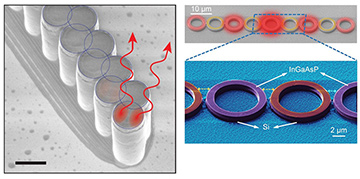 Experimental demonstration of topological lasers in exciton-polariton microcavity array (left) and coupled hybrid silicon microring resonators (right). [Enlarge figure]
Experimental demonstration of topological lasers in exciton-polariton microcavity array (left) and coupled hybrid silicon microring resonators (right). [Enlarge figure]
Topological photonics offers a novel paradigm for engineering new optical functionalities with robust performance. Equally important, such devices serve as a fertile platform for testing topological physics in a controlled environment—one where many-body interactions and nonlinearities can be tuned with high precision, beyond that achieved in electronic materials.
Originally investigated in Hermitian systems in which particle number is conserved, topological features have been recently predicted and demonstrated under non-Hermitian conditions represented by gain and loss. Despite this rapid progress, the possibility of achieving laser emission in topologically protected states had remained an open question. Over the past year, lasing action of symmetry-protected edge states in one-dimensional photonic lattices has finally been reported—by our groups in two independent studies1,2 and by the group of M. Khajavikhan in a third.3
Using different semiconductor platforms, these works demonstrated the topological protection afforded by the chiral symmetry of Su-Schrieffer-Heeger (SSH) arrays made of coupled photonic microresonators with alternating weak and strong side coupling. In one study, the array consisted of circular polariton micropillars, coupled together in a zig-zag geometry.1 The required coupling profile of the SSH array was implemented by taking advantage of the asymmetric spatial profile of the first excited modes of each micropillar, leading to the emergence of a gapped edge state. Lasing in this topological state arose through optimizing the polariton relaxation conditions, and its topological robustness was demonstrated using excitonic nonlinearities.
The other study employed ring microcavities supporting whispering-gallery-type modes, and introduced the weak-strong coupling distribution by varying the distances between the microcavities.2 These arrays were forced to lase in the topological mode by exploiting the anomalous chiral profile of the topological state that makes it immune to deliberate losses on every second site. The research team demonstrated the topological state’s robustness via structural deformations of the resonator array.
These experimental results demonstrate the material-platform versatility of topological lasers. In particular, the GaAs-based micropillars invite exploration of driven-dissipative polariton condensates in topological lattices,1 while the hybrid silicon platform used in the ring-resonator work opens the door for integrating topological lasers in silicon-based photonic chips.2
These works, pioneering the advent of topological microlasers,1–3 have been recently complemented by remarkable breakthroughs in 2-D geometries, where 1-D propagation of the lasing mode reveals genuinely novel assets.4,5
Researchers
P. St-Jean and J. Bloch, CNRS, Université Paris-Sud, Université Paris-Saclay, Palaiseau, France
A. Amo, Université de Lille, CNRS, Lille, France
H. Zhao and L. Feng University of Pennsylvania, Philadelphia, Pa., USA
H. Schomerus, Lancaster University, Lancaster, U.K.
R. El-Ganainy, Michigan Technological University, Houghton, Mich., USA
References
1. P. St-Jean et al. Nat. Photon. 11, 651 (2017).
2. H. Zhao et al. Nat. Commun. 9, 981 (2018).
3. M. Parto et al. Phys. Rev. Lett. 120, 11901 (2018).
4. B. Bahari et al. Science 358, 636 (2017).
5. M.A. Bandres et al. Science 359, eaar4005 (2018).

